I recently watched a PBS documentary on Hopper–Edward Hopper: a Love Story (an odd subtitle, if it references Hopper’s relationship with his wife, Josephine Verstille Hopper, as the subtitle doesn’t seem like a great fit), and I wanted to jot some thoughts that came to mind while looking at Hopper’s work.
I should start by saying that I’ve liked Hopper’s work for a long time, maybe starting with one of his most famous, Nighthawks, although I think I saw Gottfried Helnwein’s variation of it, Boulevard of Broken Dreams first–and that definitely colored my impression of Nighthawks
Boulevard of Broken Dreams (1984)
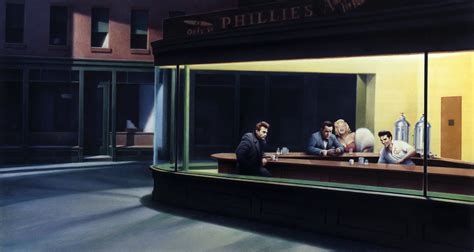
Nighthawks (1942)
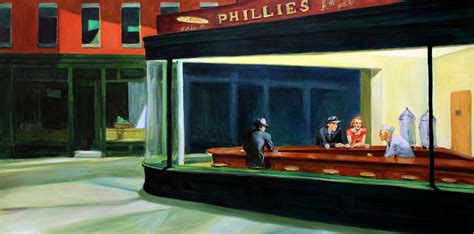
Study for Nighthawks (1941)
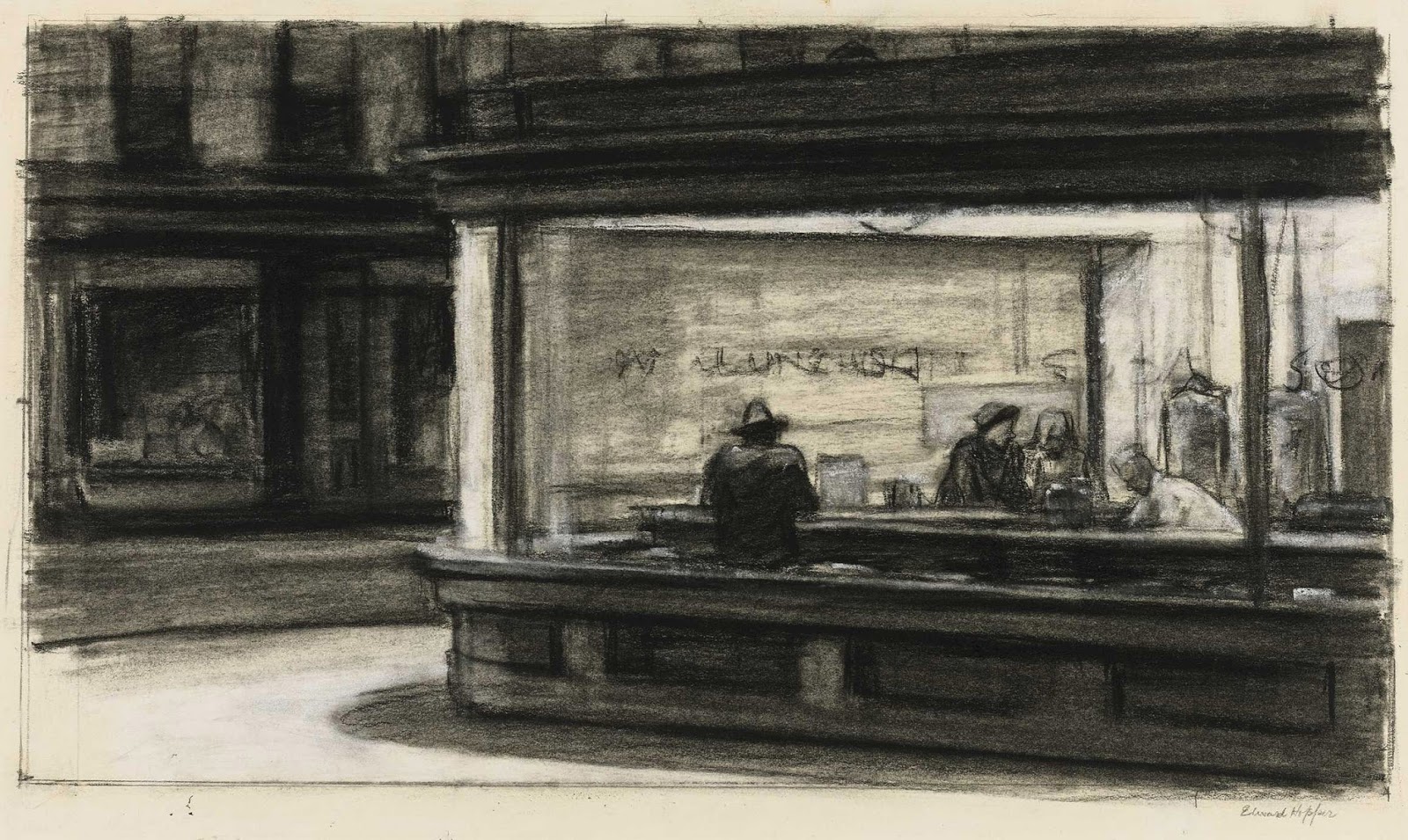
What made me like the painting? First of all, the painting may the contain the most iconic image of an American diner, in the 40s and 50s, where diners seemed like the quintessential eatery. The late night setting, the fedora–or in the Helnwein’s version, Bogart–more more specifically Rick, drunk, with despair, because “of all the gin joints in all the world” Ilsa walked into his–all this supercharged the romance of the diner, specifically the urban (read: NYC) diner.
I think I must have seen Boulevard first because I recall feeling a little disappointed when I saw Nighthawks. In the latter, the romance is there but much more muted, less flamboyant and energetic, with a heavy dose of loneliness that is absent in the former. (On a side note, looking at Boulevard on a later viewing, Elvis as a soda-jerk seemed to demeaning and broke the spell of romantic cool.)
The paintings differ in other ways. Boulevard, created in 1984, was one of many expressions of the 80’s love affair with the 1950s (e.g., Happy Days, Hard Rock Cafes,). In contrast, Nighthawks expresses the social isolation and loneliness of the individual, especially in urban spaces. Where Boulevard captures the 80s, with it’s decadence and Hollywood version of the 50s, Nighthawks captures modernism, especially the psychological and social sensibility of the modern person.
One similarity is the actual diner itself and the buildings in the background. One thing that strikes me is the diner window, especially its height and the way it curves around the corner. I don’t recall seeing a window like this, which creates a sense of unreality and maybe abstraction, like something produced in a weird dream. The absence of a door, chairs and tables and other details also add to this odd quality. Additionally, the built environment has an inert quality which has a deadening effect (cf. Christopher Alexander’s ideas) To me, these elements create a sense of desolation–both within the built environment and the individuals in the painting. This is a common feeling that Hopper’s paintings convey to me.
Addendum
A positive interpretation of Nightawks
An article from the Art Institute of Chicago suggests that the diner, lighted in contrast to the darking buildings and streets surrounding it, could be a comforting place, where people would go to be with others. Part of the basis for this interpretation stems from background details of the painting. Apparently Hopper painted this right after and in response to the bombing of Pearl Harbor. And,
It’s a plausible reading, but I don’t find it very convincing. For one thing, several other paintings have similar components–dark and/or empty buildings surrounding two people who seem alienated or distant from each other. Incorporating the context of making the painting, one interpretation could be that in ominous moments we may have a need for comfort and hope that we can find in others, but even in these moments we may not find it. We cannot escape ourselves and the modernist moment.
Addendum, 5/18/2025
Notes:
Hopper’s work and American Suburbs
I associate Hopper’s work with more urban spaces, or at least not the post-WWII suburbs, but I do think there is a connection. Drive around a typical suburb during a weekday, and you get the same sense of psychological desolation that seem present in many of Hopper’s paintings.
Two common qualities between both seem to be the absence or minimal presence of people and the dead feeling evoked by the architecture. Let me expand on this second point. The architect Christoper Alexander believes that some buildings or built environments either make one feel alive or dead. He has catalogued the necessary qualities for either. (One of the qualities that makes a structure or place feel alive is the presence of a significant number of people.) Hopefully at some point, I can post photos showing these qualities, but I’ll just say now that many of Hopper’s buildings have elements that have a deadening effect.
Additionally, people in Hopper’s paintings seem emotionally vacant and when two or more are present, they seem psychologically distant from each other. For the most part, this is done in matter of fact way.
Here are some examples:
Automat
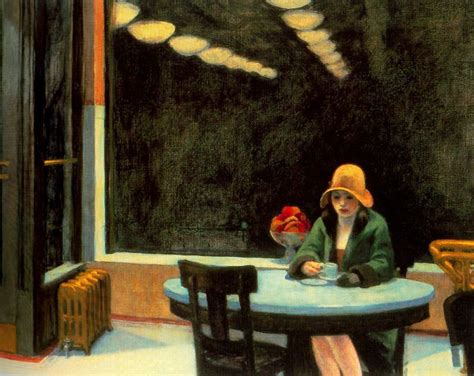
Room in NY
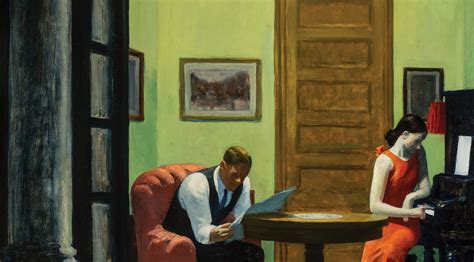
Office Worker
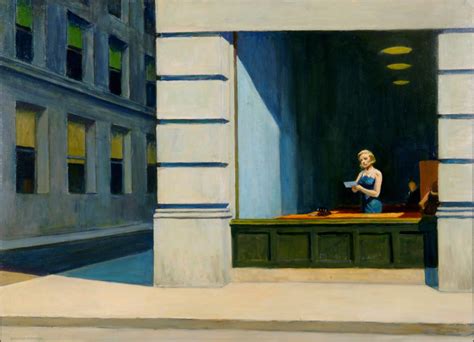
Quick addendum here: After looking over many of Hopper’s paintings, with some of my interpretations above in mind, I feel like my interpretations are overstating Hopper’s paintings. Some of them fit the interpretations, but I think many do not. I’ll try to show some of these one that don’t fit my reading later.
Related to your thoughts.
Sun in an Empty Room (1963)
https://www.wikiart.org/en/edward-hopper/sun-in-an-empty-room
And this fantastic song by the Weakerthans, with the same title.
Now that the furniture’s returning to its Goodwill home
With dishes and last week’s paper
Rumors and elections
Crosswords, an unending war
The black in our fingers
Smear their prints on every door pulled shut
Now that the last month’s rent is scheming
With the damage deposit
What’s the song about? I looked over all the lyrics, and I’m not quite sure. Based on the video, is it about town or way of life is disappearing?
Sunlight in an Empty Room (1963)
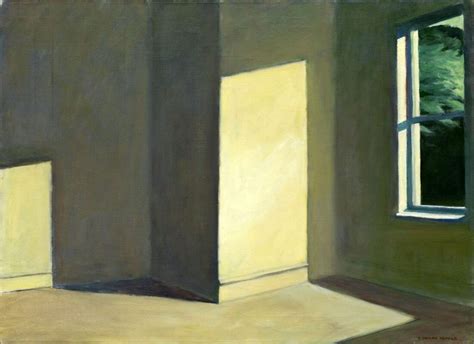
And another with a similar concept
Rooms by the Sea (1951)

Two short comments about these paintings. Both seem like the natural end point or at least the natural next step in the evolution of his work–or at least some of it. For his paintings that involve a distance , gap–or let us say emptiness–here we see a more literal manifestation of emptiness. To me, though, it’s not as effective as the other paintings with people that seem alienated in some way.